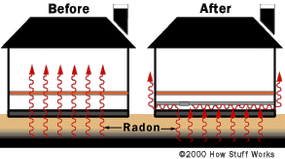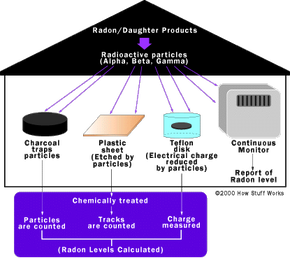How Do You Test for Radon?
Radon gas has no smell or color so a test must be done to detect it. In fact, the U.S. Office of the Surgeon General and U.S. EPA recommend that all homes be tested for radon, especially if you are buying, selling or building a home. Testing can be done by a professional or homeowner using a "do-it-yourself" kit. It is important that either the professional service or home test kit be EPA-approved.
Because radon levels can vary from day to day and from season to season, testing can be done on the short-term (two to 90 days) or long-term (greater than three months). Short-term tests are best done if the results are needed quickly and should be followed by another short-term test. Long-term tests will yield better information on a home's average year-round radon levels. Radon test devices are placed in the lowest occupied level of the home.
Advertisement
Radon Test Devices
Radon tests detect either radon gas directly or the daughter products of radon's radioactive decay. There are two categories of radon test devices, passive and active. Passive devices require no electrical power and generally trap radon or its daughter products for later analysis by a laboratory. Passive devices include charcoal canisters, charcoal liquid scintillation detectors, alpha track detectors and electret ion detectors.
- Charcoal canister and charcoal liquid scintillation devices absorb radon or its products on to the charcoal. In the laboratory, the radioactive particles emitted from the charcoal are counted directly by a sodium iodide counter or converted to light in a liquid scintillation medium and counted in a scintillation detector.
- The alpha track detectors have a plastic film that gets etched by the alpha particles that strike it. In the laboratory, the plastic is chemically treated to make the tracks visible, then the tracks are counted.
- Electret ion detectors have a Teflon disc, which is statically charged. When an ion generated from radon decay strikes the Teflon disc, the electrical charge is reduced. In the laboratory, the charge reduction is measured and the radon level is calculated.
Typically, all of the passive devices, except electret ion detectors, are available in hardware stores or by mail; electret ion detectors are usually only available through laboratories. The passive devices are generally less expensive than active devices and may require little or no special training for their use. Of the passive devices, the charcoal canisters and charcoal liquid scintillation detectors are typically used for short-term tests.
In contrast to passive devices, active devices need electrical power and include continuous monitoring devices (continuous radon monitors, continuous working level monitors). Active devices detect and record radon or its daughter products continuously. They are generally more expensive and require professionally trained testers for their operation.

Radon levels in the average home are about 1.25 picocuries/liter of air (pCi/L). If a radon test discloses levels of 4 pCi/L or greater, then some action should be taken to reduce the radon level. Radon can be reduced by preventing its entry into the home or by removing it once it has entered the home. The general solution involves active ventilation either in the basement or below the slab of the home.
